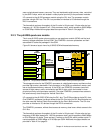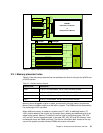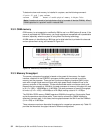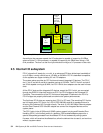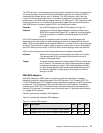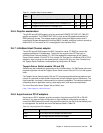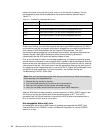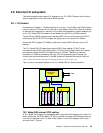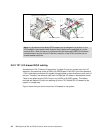
Chapter 2. Architecture and technical overview 37
The iSCSI protocol is implemented on top of the physical and data-link layers and presents to
the operating system a standard SCSI Access Method command set. It supports SCSI-3
commands and reliable delivery over IP networks. The iSCSI protocol runs on the host
initiator and the receiving target device. It can either be optimized in hardware for better
performance on an iSCSI host bus adapter (such as FC 1986 and FC 1987 supported in IBM
System p5 servers) or run in software over a standard Gigabit Ethernet network interface
card. IBM System p5 systems support iSCSI in the following two modes:
Hardware Using iSCSI adapters (see “IBM iSCSI adapters” on page 37).
Software Supported on standard Gigabit adapters, additional software (see
“IBM iSCSI software Host Support Kit” on page 38) must be installed.
The main processor is utilized for processing related to the iSCSI
protocol.
Initial iSCSI implementations are targeted at small to medium-sized businesses and
departments or branch offices of larger enterprises that have not deployed Fibre Channel
SANs. iSCSI is an affordable way to create IP SANs from a number of local or remote storage
devices. If Fibre Channel is present, which is typical in a data center, it can be accessed by
the iSCSI SANs (and vice versa) via iSCSI-to-Fibre Channel storage routers and switches.
iSCSI solutions always involve the following software and hardware components:
Initiators These are the device drivers and adapters that reside on the client.
They encapsulate SCSI commands and route them over the IP
network to the target device.
Targets The target software receives the encapsulated SCSI commands over
the IP network. The software can also provide configuration support
and storage-management support. The underlying target hardware
can be a storage appliance that contains embedded storage, and it
can also be a gateway or bridge product that contains no internal
storage of its own.
IBM iSCSI adapters
New iSCSI adapters in IBM System p5 systems provide the advantage of increased
bandwidth through the hardware support of the iSCSI protocol. The 1 Gigabit iSCSI TOE
(TCP/IP Offload Engine) PCI-X adapters support hardware encapsulation of SCSI commands
and data into TCP and transports them over the Ethernet using IP packets. The adapter
operates as an iSCSI TOE. This offload function eliminates host protocol processing and
reduces CPU interrupts. The adapter uses a Small form factor LC type fiber optic connector
or a copper RJ45 connector.
Table 2-6 provides the orderable iSCSI adapters.
Table 2-6 provides the orderable iSCSI adapters.
Table 2-6 Available iSCSI adapters
Feature
code
Description Slot Size Max
1986 Gigabit iSCSI TOE PCI-X on copper media adapter 64 Short 3
1987 Gigabit iSCSI TOE PCI-X on optical media adapter 64 Short 3



